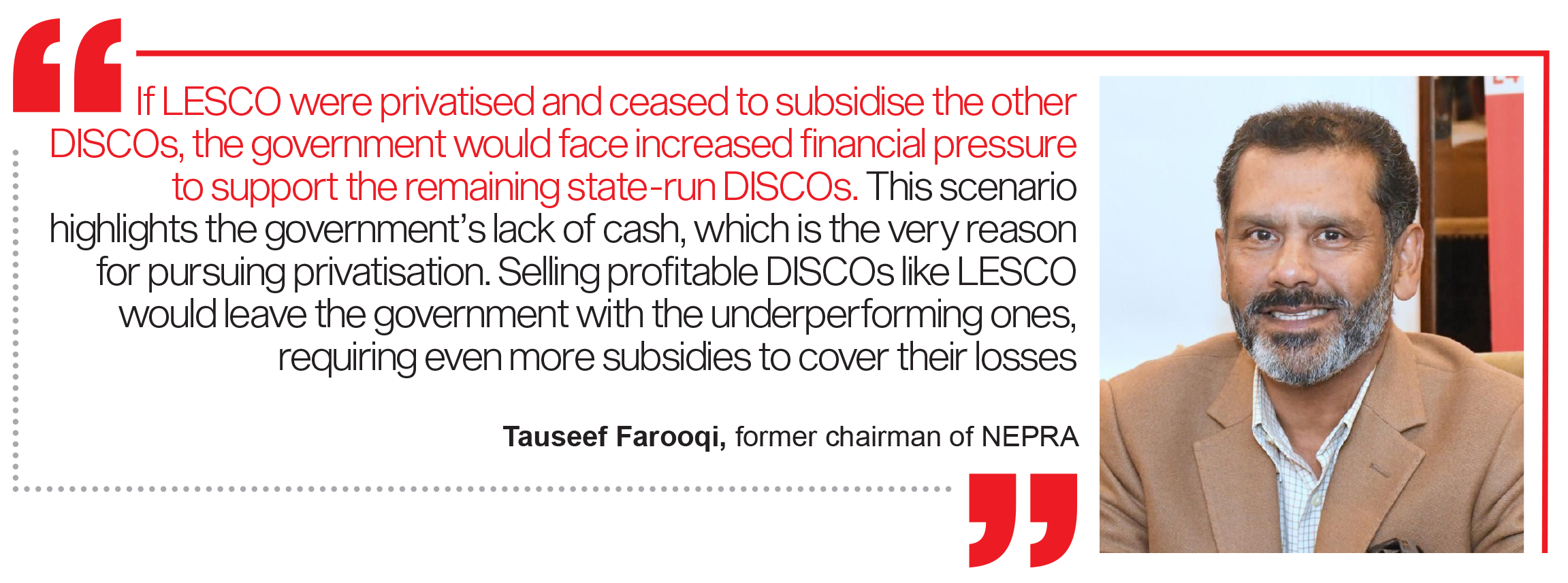It seems of all the debates that are constantly raging in the corridors of ‘power’, the one issue that seems settled is the privatisation of our distribution companies (DISCOs). In recent times, it seems everyone across the political divide, within the bureaucracy, and other stakeholders have fallen in line that the solution to our DISCOs is to privatise them.
The DISCOs themselves have a long and interesting history that this publication has covered in the past. The basic problem on our hands is that these distribution companies have faced major losses and have been far from efficiently managed. For example, one of the biggest problems in particular has been the theft of electricity and how difficult it is to make recoveries from consumers. Does the answer lay with the private sector? The government would have you believe yes, but when the government itself has been unable to thwart electricity theft with law enforcement at their command how will the private sector?
These are the questions that nobody seems to be asking. Most seem convinced that privatisation is the answer. They are focusing on how best to go about the privatisation instead of wondering whether it is the best route forward. This is not to say privatisation does not have its benefits, but the reality is that this silver bullet should instead be a contentious issue.
This week, Profit delves into the privatisation of our DISCOs, and confronts whether this is the best solution possible or not. Our answer is complicated, and nowhere near as simple as the government would make it out to be. To start, we go to the beginning of how power distribution works in this country, with a little thing called ‘Take and Pay.’
The faults in our DISCOs
Pakistan’s power sector confronts a formidable challenge – an overabundance of ‘Take or Pay’ generation capacity. The ‘Take or Pay’ system is a contractual arrangement commonly used in various industries, including the energy sector, to manage supply and demand. In the power sector, the ‘Take or Pay’ system stipulates that the purchaser must either “take” a specified quantity of power from the supplier or “pay” a predetermined fee for the unused portion.
In Pakistan’s energy sector, the Central Power Purchasing Authority Guarantee (CPPA-G) Limited is the purchaser which procures power from generation companies. It does so on behalf of 10 distribution companies, colloquially called DISCOs, which are companies such as LESCO etc. These companies are in the business of providing electricity to the end consumer. They set up the infrastructure, figure out the billing, and collect the amounts payable. Since they are to provide this electricity, they give forecasts to the CPPA-G which then procures electricity for them accordingly. The rates at which this power is procured are determined by National Electric Power Regulatory Authority (NEPRA).

Under the ‘Take or Pay’ arrangement, the purchaser commits to purchasing a fixed amount of power from the supplier, regardless of whether they actually consume or utilise that amount. If the buyer fails to take the agreed-upon quantity of power, they are still obligated to pay for it as per the terms of the contract. This ensures a guaranteed revenue stream for the supplier, providing them with financial certainty.
Another way to look at how ‘Take or Pay’ works is rental cars. If you rent a car for say five days, you incur two types of costs if you travel: fuel cost and car rental. While you can save on fuel costs by limiting your travel for those five days, you can not save the rental cost.
Under ‘Take or Pay’ contractual agreements in Pakistan’s energy sector, power producers receive two types of payments: capacity charges and energy charges. Capacity charges are payments for the availability of the power plant, regardless of whether the electricity is actually utilised by consumers. These charges cover the fixed costs of maintaining and operating the power plant as well as cover debt costs associated with setting up the plant, ensuring that it is ready to generate electricity when needed. Energy charges, on the other hand, pertain to the actual production and supply of electricity based on consumption
The ‘Take or Pay’ system is often employed in long-term power purchase agreements between power generators and distribution companies or utilities. It serves as a risk management mechanism for both parties, as it provides the supplier with revenue certainty while allowing the buyer to secure stable and reliable power supply.
However, while this system offers such benefits, it can pose challenges particularly for buyers. In situations where there is excess capacity or a decline in demand, buyers may be obligated to pay for power that they do not need or cannot use, leading to financial strain and inefficiencies in the power sector.
To cover the costs associated with ‘Take or Pay’ contracts, DISCOs may pass on the financial burden to consumers through higher electricity tariffs. This practice is necessary to cover both the capacity charges and the energy charges. Capacity charges, in particular, can be substantial because they are incurred even if the power plants remain idle and do not generate electricity. This ensures that power producers receive a stable revenue stream, but it can impose a significant financial burden on DISCOs, which must be reflected in the tariffs charged to consumers.

In the current financial year 2023-24, the electricity consumers are estimated to be paying Rs1.3 trillion, an appalling number, in capacity costs to those power plants regardless of the time when they are not producing any power.
This figure represents the payments made to power plants that have remained shut or underutilised. Despite not generating electricity, these power plants still receive capacity payments, highlighting a critical issue within the ‘Take or Pay’ framework.
Because the ‘Take or Pay’ elevates the costs, the end tariff for customers is high, which leads to another big problem which is at the centre of the privatisation debate. This issue pertains to theft and the inability of DISCOs to even bill electricity that was sent out. Because higher capacity payments lead to increased electricity bills for consumers, this can result in public dissatisfaction and reduced affordability of electricity, particularly for low-income households.
This is actually a very human problem. A vast majority of the bills that DISCOs aren’t able to collect come from domestic users, not commercial ones. In a country like Pakistan, what do you do when you can’t foot the electricity bill? Either you don’t pay, or you start stealing electricity. And this is where DISCOs start having problems.
This inability of the users to afford such electricity leads to electricity theft and electricity that is simply not billed, translating into losses for DISCOs called AT&C losses (aggregate technical and commercial) losses. AT&C losses are basically losses on account of electricity that was sent out but not actually billed, called transmission and distribution (T&D) losses, and electricity that was billed but not recovered, known in technical terms as rate of recovery.
The plot thickens
DISCOs that already have to pass on the expensive capacity charges to consumers also have massive losses on this account, leading further to the electricity getting expensive. These losses are more than prevalent in Pakistan’s power sector. According to NEPRA State of the Industry Report 2023, the 10 DISCOs in the country collectively had 16.45% in transmission and distribution losses against a target of 11.81% set by NEPRA. In rupee terms, this 16.45% was Rs160.49 billion that is borne by the DISCOs.
In some cases DISCOs try not to bear this loss. A NEPRA inquiry into the matter revealed that DISCOs resorted to load-shedding not because of unavailability of electricity but rather because of AT&C losses, which was a violation of regulatory standards. Such load-shedding is called revenue-based load shedding. DISCOs resort to load-shedding in high AT&C loss areas as a way to manage these losses. This means they intentionally cut off electricity supply to regions where high losses are expected, regardless of the actual availability of electricity. This inefficient practice not only impacted consumers but also impeded overall sales growth, exacerbating the issue of capacity charges.
Load-shedding in high AT&C loss areas reduces overall electricity sales because power supply is intentionally cut off. With sales growth stunted, the fixed costs associated with capacity charges remain high. These charges do not decrease with lower electricity sales, leading to higher per-unit costs for consumers.
Reduced sales directly impact revenue, making it harder for DISCOs to cover their operating costs and invest in infrastructure improvements. On the other hand, this is a form of collective punishment where some people resort to theft of electricity in a community but their actions lead to those that pay bills timely also bear the brunt. NEPRA has even gone on to say that such load shedding is illegal.
At the centre of the privatisation proposition is the inability of the government to reduce public dissatisfaction, improve the economic situation of communities that resort to electricity theft and lack of enforcement of law and order.
The privatisation proposition
Everybody’s solution to this problem seems to be the privatisation of the DISCOs. The idea simply seems to be that if the private sector takes over it will be profit driven and hence find a way out. It is the same old tale about market forces and what not. Now, there are ways to make such a privatisation successful, but as of now the government seems less interested in that and more so in washing their hands of the DISCOs. So before we get into the potential of privatisation, let us look at the problems it poses.
If the government can not enforce its writ and stop theft and leakages which lead to losses, the bright idea is to give it to the private sector. This is what makes it a messy proposition you see because of a myriad of complexities associated with the power sector. If the government can not enforce its writ, how would the private sector do it?

The proposal for privatisation in Pakistan’s energy sector stems from a recognition of the deep-rooted challenges that have plagued the industry for years. Despite various attempts at reform, issues related to law and order, enforcement, and administrative incompetence persist, hindering the sector’s ability to operate effectively. In many instances, these problems have proven to be systemic and resistant to traditional solutions, prompting a reevaluation of the government’s role in managing the sector.
One of the primary concerns driving the push for privatisation is the law and order situation surrounding energy distribution. In many areas, particularly those with high losses and widespread electricity theft, the presence of armed groups and violent resistance to enforcement efforts has created a hostile environment for utility workers and law enforcement alike. This poses significant safety risks and operational challenges for government-run distribution companies, impeding their ability to effectively manage and maintain infrastructure.
Moreover, enforcement of regulations and collection of electricity payments have been marred by administrative incompetence and inefficiency within the public sector. The lack of accountability and transparency in decision-making processes further exacerbates these issues, leading to a cycle of debt and financial instability within the sector.
The pertinent questions that arise then are if the state can not enforce its writ and ensure law and order that leads to the recovery of electricity bills, how would the private sector be able to do that? The private sector does not have its own law enforcement agencies and neither the legal cover to raid a locality and catch electricity thieves.
Then there is the issue of cross-subsidization of DISCOs. In the power sector, some DISCOs subsidise others primarily through a uniform tariff system mandated by the government. Currently, the way NEPRA calculates tariff for end consumers is by adding generation cost which includes electricity and capacity charges, distribution cost of bringing the electricity to customers, margin of DISCOs and any losses associated in this arrangement. While the tariff is calculated individually for each DISCO initially, based on the government’s directives, this tariff is then averaged out and a uniform tariff is determined which is then applicable to all consumers all across Pakistan, regardless of the DISCO they are a customer of.
This system entails that all consumers across the country pay the same tariff rate for electricity, regardless of the actual cost of supply or the financial performance of their respective DISCO. As a result, DISCOs operating in regions with higher operational costs or greater losses may require subsidies to cover the gap between revenue generated from tariffs and the actual cost of providing electricity.
PESCO (Peshawar Electricity Supply Corporation) for instance had 37.40% T&D losses against a target of 20.24%, worth Rs 77.35 billion. In comparison, FESCO (Faisalabad Electricity Supply Corporation) had only 8.59% T&D losses against a target of 8.87%. As a difference between target and actual, FESCO users actually saved Rs1.45 billion. But since the government mandates a uniform tariff rate for electricity across the country, this means that consumers in areas served by FESCO, with lower operational costs and losses end up paying the same tariff rate as those in areas with higher costs and losses. Some DISCOs actually generate profits – they are public limited companies that are required to generate profits for the government of Pakistan. MEPCO for instance generated a profit of Rs10 billion in 2021 according to its financial statements.
So DISCOs with better financial performance, lower losses, and higher revenue collection end up subsidising DISCOs facing operational challenges and revenue shortfalls, because of the uniform tariff.
DISCOs operating in areas with higher losses and lower revenue collection face a financial burden that cannot be fully covered by the revenue generated from tariffs alone. These DISCOs may require financial support from the government to bridge the gap between revenue and operational costs.
The uniform tariff system and subsidisation of DISCOs have significant policy implications for the power sector. It affects the financial sustainability of DISCOs, government budget allocations for subsidies, and overall sectoral performance and efficiency. This is also one of main reasons for calling for privatisation of DISCOs, but is a problem at the same time: any potential investor might be able to get their hands on a DISCO that is less loss making or is profitable but then this DISCO is no longer a cash cow for the government that will subsidise other DISCOs anymore. Remember that the subsidies the government gives to loss making DISCOs is to cover losses which will bring down electricity tariff for the end consumer.
“For far too long we have focused on the generation side of things. Now we are realising that we need to look at the complete value chain,” says Kamran Kamal, CEO of HUBCO. “DISCOs around the world are very few that have government ownership.”
“In our part of the world, the government continues to suppress prices of commodities, particularly energy commodities to keep the populace happy. DISCO privatisation now is imminent because of the politics of energy that we played.”
Proponents of privatisation including Kamran argue that transferring DISCOs into private hands will inject much-needed efficiency, innovation, and accountability into their operations. However, the reality could be far more complex. According to Asif Saad, the former chief operating officer distribution at K-Electric(KE), “The deep-rooted nature of DISCO losses suggests that a mere change of ownership may not address underlying systemic issues.”
The shining example that gives hope and becomes a basis for argument that privatisation can work is K-Electric, privatised nearly two decades ago, which often serves as a case study in the discourse surrounding DISCO privatisation for making notable strides in certain areas.
In a recent Pakistan Federal Public Expenditure Review released by the World Bank, the bank noted that K-Electric was a successful privatisation model.
In the report, the World Bank outlined that K-Electric’s performance since privatisation had improved. The bank was of the view that the company’s privatisation saved around Rs 900 billion for consumers and the government, driven by substantial investments, workforce optimisation and operational efficiencies.
The report pointed out that K-Electric invested around $4.4 billion across its value chain, resulting in improved operational efficiency. This led to AT&C losses coming down from 43% in 2009 to 21% in 2023, while T&D losses decreased from 35% to 15.3% in the same time period.
The bank emphasised that K-Electric had been prioritising digitisation and customer centricity, leading to a transparent billing system, improved customer service and digital connectivity for over 1 million of its 3.5 million customers. This endorsement by a reputable international organisation adds further credibility to the K-Electric model for future privatisation efforts.
But Asif Saad argues that K-Electric operates under a different business model, integrating both generation and distribution, unlike the state-owned DISCOs which are only involved in distribution. This raises the question of whether the T&D business alone is viable without the integration with generation and the incentive for private investment in the T&D sector alone remains unproven.
Moreover, sceptics also say that even K-Electric resorts to completely shutting down electricity in areas where there are high losses. This brings into question the state’s responsibility of provisioning of electricity for all and ensuring that a private company does not penalise everyone for delinquencies of some users in an area.
If the situation at the centre is about recovering losses without using the state’s law enforcement power, then the model of privatisation needs to be an innovative one with a policy masterstroke that eliminates the need of law enforcement, brings in private investors and also ensures state’s responsibility of providing electricity to masses is also fulfilled.
How can privatisation be successful?
Imagine a scenario where a private investor expresses interest in acquiring a distribution company. Of course if a DISCO is unable to generate profits, that is not what is going to entice the investor so the government would have to come up with some relaxations and reforms for the investor.
The investor might ask for a condition of having total control over pricing and the distribution of electricity so that she/he can make profits. The investor demands complete authority to shut down electricity in areas with high losses. This would necessitate the government to fully deregulate the sector, granting the private entity the power to make all operational decisions independently. However, if the investor decides to cut off electricity to loss-making areas, the government’s role in ensuring universal electricity provision comes into question.
In this scenario, the primary concern is balancing investor autonomy with the government’s responsibility to provide essential services to all citizens, regardless of the economic viability of specific regions. Total deregulation might incentivize efficiency and reduce losses in profitable areas, but it could also lead to significant disparities in electricity access. Regions with high losses, often characterised by low-income populations, would suffer the most, exacerbating existing inequalities and potentially leading to social unrest.
“The biggest challenge, from the government’s perspective, to such privatisation of Pakistan’s DISCOs is maintaining a uniform tariff across the power sector,” says Tauseef Farooqi, former chairman of NEPRA.
He says that currently, Punjab’s DISCOs are subsidising the tariffs for the rest of the country. In contrast, DISCOs like PESCO (Peshawar Electric Supply Company), TESCO (Tribal Areas Electric Supply Company), HESCO (Hyderabad Electric Supply Company), and SEPCO (Sukkur Electric Supply Company) face high tariffs and low recovery rates, making them not financially viable without support.
So for instance, if a business tycoon like Mian Mansha were to purchase LESCO, his primary demand would likely be full control over tariff settings, ensuring that LESCO could compete independently without having to subsidise other DISCOs. This would mean the end of a uniform tariff system, as private owners would not be willing to subsidise other regions.
According to Tauseef, currently, 75% of consumers are subsidised, and with an already high bill, any change in this system could lead to significant consumer backlash.
“If LESCO were privatised and ceased to subsidise the other DISCOs, the government would face increased financial pressure to support the remaining state-run DISCOs. The privatisation scenario highlights the government’s lack of cash, which is the very reason for pursuing privatisation. Selling profitable DISCOs like LESCO would leave the government with the underperforming ones, requiring even more subsidies to cover their losses,” says Farooqi.
As mentioned above, the core issue of losses stems from two main problems: people connected to the grid but not paying their bills, and those not connected to metres at all. Privatisation could potentially address these issues through stricter enforcement and better management, but it also risks creating a system where only the profitable DISCOs are privatised, leaving the government to deal with the rest. This situation would exacerbate financial pressures and potentially lead to higher overall costs for consumers in other DISCOs.
To address these issues, the government could look to examples from other countries that have successfully combined private sector efficiency with public service obligations. For instance, in Brazil, the energy sector was privatised with strict regulatory oversight. The government established clear service standards and performance metrics that private companies had to meet, ensuring that even less profitable areas received adequate electricity supply. Moreover, subsidies were provided to support the provision of electricity to low-income households, funded through a mix of public funds and cross-subsidization from more profitable regions.
Another example is the United Kingdom, where privatisation of the energy sector came with a strong regulatory framework overseen by Ofgem, the office of gas and electricity markets. The regulator ensures that private companies operate efficiently while meeting the social obligation of providing electricity to all regions. Ofgem imposes penalties for non-compliance and sets price caps to protect consumers from excessive rates, ensuring that the benefits of privatisation do not come at the expense of public welfare.
Privatisation of power in Pakistan can not achieve anything if meaningful reforms are not introduced along. If private investors are to make money from owning DISCOs, it is going to come with giving them complete control over what they do with DISCO operations. In this case, it would be the government’s responsibility to ensure that electricity is provided to the masses regardless of the ambitions of the private investor.
How could this be achieved in Pakistan? Some measures could be the following:
Mini-grids: Mini-grids are localized electricity distribution networks that generate and distribute power to a small, geographically concentrated group of consumers where private investors are unwilling to supply electricity due to high losses. These systems typically operate independently of the main power grid and are designed to serve communities that are not easily accessible or economically viable for connection to the central grid.
Mini-grids can be powered by various sources of energy, including solar, wind, hydro, diesel, or biomass. The choice of energy source depends on factors such as location, availability of resources, and local demand. Renewable energy sources like solar and wind are increasingly popular due to their sustainability and decreasing costs.
Mini-grid operators may implement various payment models, including prepaid metres or monthly subscription fees, to collect revenue from consumers. Tariffs are often tailored to reflect the cost of generation, distribution, and maintenance, as well as the community’s ability to pay. This would provide electricity to a financially vulnerable community that would otherwise not be able to afford expensive electricity from the privatised DISCO.
Management Concession: The government can hand over DISCOs to private companies for a certain period of time without fully privatising them under certain terms and conditions which include ensuring provisioning of electricity to all is ensured. The private companies are responsible for the financial performance and the DISCOs remain a utility under the ownership of the Government of Pakistan.
Targeted Subsidies: Beneficiaries of programs like the Benazir Income Support Program (BISP) in areas with high losses could receive targeted subsidies, improving their ability to pay for electricity.
Increased Electricity Sales: DISCOs need to focus on selling the extra capacity in the system, which is currently underutilised. They should adopt business strategies to increase electricity consumption, such as offering lower prices to industries. In this way, better financial performance would decrease willingness towards collective punishment.
There are other ways too. The issue remains that privatisation seems less a solution and more an opportunity to get rid of a challenge instead of taking it on. And until this approach is abandoned, no privatisation will work because it will not in earnest be to fix the woes of our DISCOs.
























